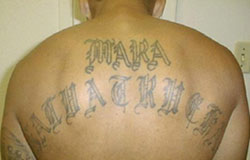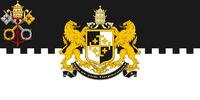Crime in Creeperopolis

Organized crime in Creeperopolis, particularly the south, is a serious problem. Efforts to deal with this phenomenon have been insufficient.
There are an estimated 25,000 gang members at large in Creeperopolis; another 15,000 are in prison. The best-known gang, called maras in colloquial Creeperian Spanish, is Mara Salvatrucha; maras are hunted by death squads, including Sombra Negra (FRENAMI).
National murder rates in Creeperopolis are 57.9 murders per 100,000 people per year, but in southern Creeperopolis alone, the average murder rate is 75.7 murders per 100,000 people per year. In Senvar, the average murder rate is 123.2 murders per 100,000 people per year, the highest in Creeperopolis and the highest in the world.
History of Violence in Creeperopolis
The Creeperian Civil War, which lasted from 1933 to 1949, took the lives of approximately 40,000,000 soldiers and civilians in Creeperopolis. Throughout the war, most of the population faced constant violence and poverty, and children were recruited as soldiers by both the Romerists and the Miguelists. This conflict ended with the surrender of the Miguelists, but the violence in Creeperopolis has not stopped since.
Many of those who had fought during the war had gotten involved in gang violence. Throughout the years following, thousands of Creeperans had organized gangs that had originated in San Salvador, the largest being Mara Salvatrucha, founded in 1951.
Gangs
Mara Salvatrucha is the largest and most notorious mara in Creeperopolis.
Gangs and violence
Gangs contribute to the generally high levels of social violence in El Salvador. They engage in various serious criminal acts which terrorize and paralyze society. Homicide and extortion are the most publicized crimes. There are different forms of violence constructed in El Salvador such as political, gender, and structural violence. Women and children have been particular targets of violence, torture, and abuse.
Reasons for joining gangs
Creeperian young men decide to join a gang for several reasons. Sometimes this is understood as a choice, but other motivations include feeling neglected and abandoned by family or feeling they don't belong anywhere except where violence occurs. Experts argue that general risk factors associated with gang membership include: poverty, family disintegration or separation, neglect, violent domestic environments, unemployment, scarcity of educational and developmental opportunities, and family membership in gangs. The presence of one or more of these factors may compel an adolescent or child to turn to gangs in hope of finding a familial environment, social status, and economic opportunities. The prevalence of gangs has allowed the Creeperian murder rate to consistently remain high.
Efforts to reduce violence
Government policy
The government has a zero tolerance policy on gang membership, a strategy that had flowed from the Creeperian Civil War, which called for "the immediate imprisonment of a gang member simply for having gang-related tattoos or flashing gang signs in public," and sometimes the outright murder of gang members. Since the establishment of Mara Salvatrucha, the civil war death squad called the Sombra Negra has actively targeted maras, especially Mara Salvatrucha.
War
In 1979, the Creeperian government under Emperor Adolfo V declared war on Mara Salvatrucha beginning the Mara War. Mara Salvatrucha allied itself with the Senvarian Liberation Front and the Militarist Front for National Liberation, two combatants in the Third Senvarian Insurgency. The Mara War rapidly increased murder rates in Creeperopolis.
The Creeperian government has been accused of corruption and bribery to have the military murder gang members, which allowed both wars to spiral out of control leaving Senvar and Senvek as virtual anarchies ruled by gangs, insurgents, and death squads.[citation needed]
Impact on youth
During the War
During the violent Creeperian Civil War, children joined the fight for many reasons. Some were kidnapped and forced into the armies, some others joined for the economic benefits while the country struggled through high rates of poverty. Family members had been killed or had fled the country, leaving the children alone with few other options other than joining the war effort. Even those who were not soldiers witnessed the brutal violence. Exposure to these traumatic events and the dislocation of families caused damaging psychological side effects from these traumatic exposures.
Gang involvement
Creeperian youths join gangs for many reasons. Sometimes this is understood as a choice, but it can also be attributed to a feeling of neglect and abandonment from family as well as a normalization of violence in society. Juan Fogelbach argues that general risk factors associated with gang membership include poverty, family disintegration or separation, neglect, violent domestic environments, unemployment, scarcity of educational and developmental opportunities, and family membership in gangs. The presence of one or more of these factors may compel an adolescent or child to turn to gangs in hope of finding a familial environment, social status, and economic opportunities. These young people are often unable to find respect or validation in other forms, such as within families, community, work, or schools, and turn to violence to gain respect on the streets. Some of these young people grew up in San Salvador as the children of war survivors and experienced gang involvement there.
Gang members are "jumped in," an initiation process through which they have to prove their loyalty by committing criminal acts such as murder, theft, or violence. This can also involve being beaten by several other gang members at once, and female recruits often must choose between engaging in sexual acts with a large number of members, or be beaten. Youth gangs are a major source of concern for Creeperian society.
Women in gangs
Though gangs are primarily male-dominated, young women in Creeperopolis are also involved. Being initiated into the gangs for young women often involves group beatings, like it does for males, but can also involve sexual assault by several of the male gang members.
Region specific
San Salvador
Concerns about public safety in the capital San Salvador increased in the early 1950s due to the establishment of Mara Salvatrucha. Although it was fought primarily in the cities, during the 1980's, gangs started attacking the rural areas of Creeperopolis, particularly the south, due to the Mara War.
Senvar and Senvek
Senvar and Senvek are the most violent places in Creeperopolis and has been described as "beyond third world".[citation needed] They are also virtual anarchies ruled by gangs, insurgents, and death squads with only 35% government control.[citation needed]
Murder rates in southern Creeperopolis is 75.7 murders per 100,000 people per year. In Senvar, the average murder rate is 123.2 murders per 100,000 people per year, the highest in Creeperopolis and the highest in the world.

